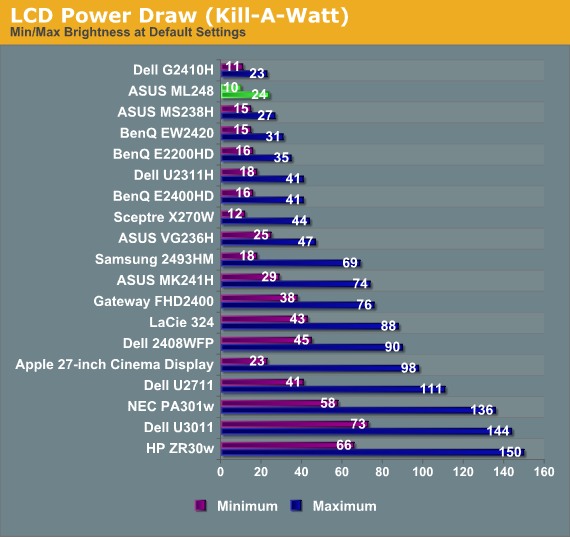ASUS ML248H: Thin for the Win?
by Chris Heinonen on October 27, 2011 12:00 AM ESTPower Consumption

The ASUS ML248H certain does well on our power consumption test. It pulls just 24 watts with the backlight at max, and only 10 watts with the screen at minimum brightness. Of course, since the screen only put out 251 nits and many other displays can output far more, it’s easier to achieve that lower power consumption number. Po perhaps we’ll have to develop a better way of comparing power requirements, such as nits per watt per square inch or something similar. For now, at least ML248H is good for potentially reducing power use.
Final Thoughts
Aside from having a slim cabinet, the ASUS ML248H doesn’t have too much to recommend it. The stand looks nice, but it didn’t work well at all in my desk environment and was barely adjustable. The TN panel loses contrast and color at the edges with normal viewing angles, and it has big backlight uniformity issues that prevent me from recommending it for any sort of print or photo use.
For gaming I suppose it does well, with under a half frame of lag, but there are now VA and IPS models out there that can do as well, without the TN issues. Some of the style choices led to other compromises, like an OSD button system that often frustrated me, and having to use an external power brick, which I really hate having to find a place for on my desk.
In the end, it’s difficult to recommend the ASUS ML248H for most users. If you want a high quality LCD, there are far better options, although they’ll certainly cost more. If you need a thin display for your desktop, there are other choices out there that offer better performance in the same form factor. At $200, the ML248H just doesn’t seem to offer enough to really set it apart from the competition.










57 Comments
View All Comments
Exodite - Thursday, October 27, 2011 - link
I believe you may have misinterpreted my one-word reply.I don't particularly see the need for a new article title, I'm merely confirming my agreement with rsgeiger regarding the horrendous bezel on the display in question.
There's no saving grace for that IMO, my apologies to ASUS.
JarredWalton - Friday, October 28, 2011 - link
It was a response to this thread in particular, not you Exodite. :-)ProDigit - Friday, October 28, 2011 - link
then you should have posted a thread, instead of posted a reply.It seems people on anand are eager to reply on the first comment, so their reply will stay on the first page.. I've noticed so far...
rsgeiger - Monday, October 31, 2011 - link
Point taken Jarred. I guess my interpretation of the title, even with with the question mark, just triggered a reaction in me about the market and where it is headed. I have no issues in general with your writing or choice of title (most times :-)On another note, I didn't expect to get so many responses. I'm glad my taste is shared by others.
Zap - Thursday, October 27, 2011 - link
I also agree. Ugly bezel. The bezel is what you see when you are actually using the monitor, so it should be unobtrusive. Don't make the bezel "fancy" and don't use it for advertising space. If you want to go fancy with "thin," then make a thin bezel. Want to see something impressive? Samsung has big screen HDTVs with ultra thin bezels. I think they are marketing it as less than a quarter inch. On a huge 46-65" screen (the size range they make) how big will that bezel look from your couch? Now THAT is what I call impressive!http://www.samsung.com/us/topic/ultra-slim-bezel-t...
NCM - Thursday, October 27, 2011 - link
And while we're on the subject of aesthetics, I take issue with the article's claim that the rear appearance doesn't matter. In our office the rear of virtually every display is visible, and other than the Apple displays they all look like butt—appropriately, you might say. (Of course this Asus monitor pretty much looks like butt from any angle.)Is a little attention to wire management and a clean appearance on the back really so much to ask?
ProDigit - Friday, October 28, 2011 - link
Strange butt you have, besides, I don't care about the back of a monitor. I'm not the one looking at it. If you don't like it, then throw a towel over it.Valitri - Thursday, October 27, 2011 - link
Everyone is so negative about TN panels. How many of you actually use IPS screens? Do you use these for gaming, how is it?I currently use, admittidely only a mediocre, Samsung P2770 27" TN monitor with a 1080p resolution. My next monitor I am considering 120hz to reduce tearing in gaming. I don't believe you can get that in an IPS screen right now. My only experience with an IPS screen is my iPhone 4, which I absolutely love. I am definately more concerned with tearing and input lag (mouse lag) then I am accurate color reproduction and would like to get some face time with an IPS to see how it really compared.
know of fence - Thursday, October 27, 2011 - link
Vsync is the procedure/setting that removes horizontal screen tearing. It has been explained here on Anandtech many a time.http://www.anandtech.com/show/2794/2
My guess is that 120Hz screens exist mainly for (shutter glasses) 3d support, because at 60 Hz it causes headaches.
JarredWalton - Thursday, October 27, 2011 - link
That's true, but running at 120Hz does tend to reduce the perception of image tearing because the display is refreshing so quickly.